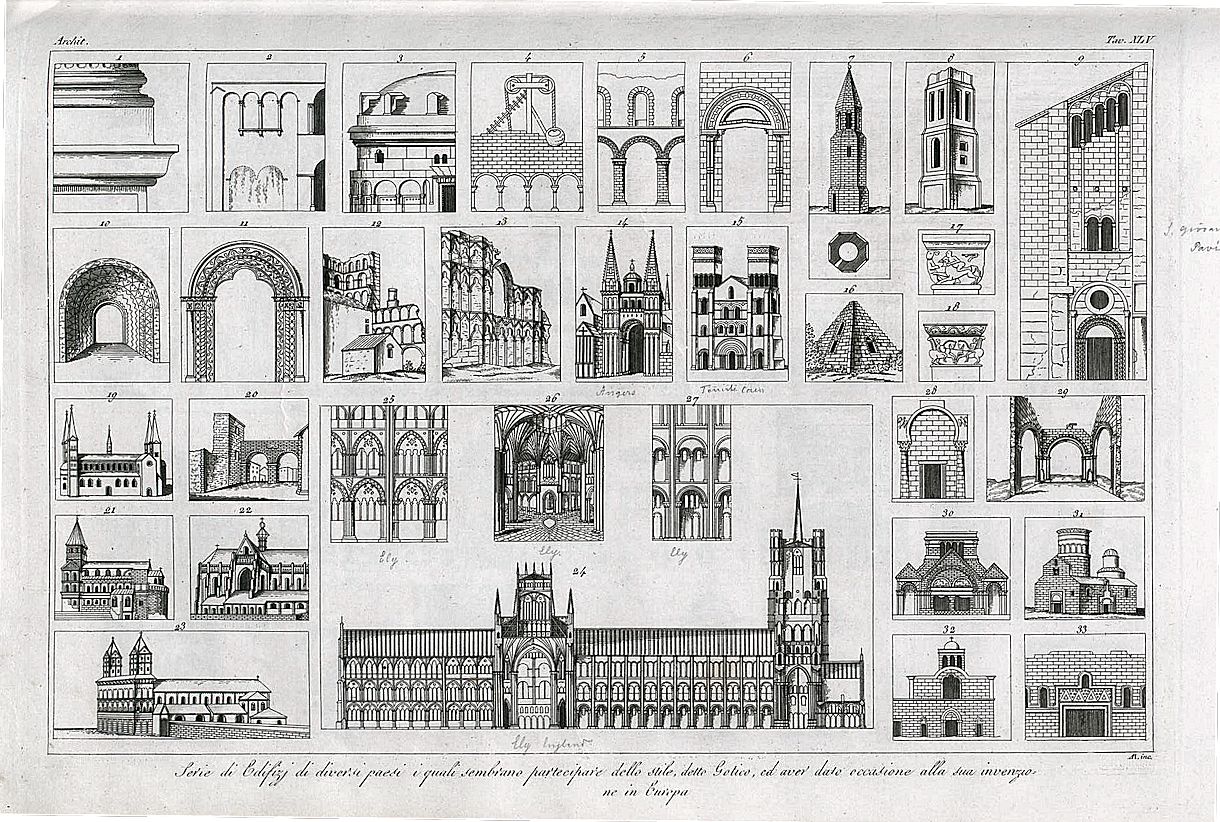1. Profile of the base of column and pedestal from the Arch of Constantine, repreoduced in this plate, as also the following numbers, to recall the low state into which art had fallen in Italy, from the fourth to the sixth centuries.
2. Half the façade of the Palace of Theodoric at Ravenna.
3. Portion of the façade of the Mausoleum of Theodoric at Ravenna.
4. Ancient construction of the Abbey of St. Albans, built by the Saxons in the fifth and sixth centuries.
5. Remains of the conventual Church of Ely, constructed during the Heptarchy, about 637.
6. Entrance doorway of the same church.
7. Plan and elevation of an octagonal tower, with round arches, formerly in the cemetery of the Church of Sts. Innocents at Paris; constructed in the sixth century, it was demolished in the year 1778.
8. Tower of the sixth century, with round arches, part of the front of St. Germain-des-prés.
9. Portion of the façade of St. John in Borgo at Pavia, seventh and eighth centuries; the façade is given entire pl. 64/6, and the plan pl. 73/27.
10. Doorway of Ifley Church, near Oxford.
11. South door of Ely Cathedral; the inner arch is trefoiled, a figure used to recall the idea of the Holy Trinity.
12. Remains of the Monastery of Kelso in Scotland, founded by David I, in 1128.
13. Ruins of the Church of St. Mary, near York, rebuilt in 1270.
14. Façade of the Church of St. Maurice at Angiers; thirteenth century.
15. Front of the Church of the Trinity at Caen, built by the order of William the Conqueror in 1061.
16. Remain of the Oratory of Abelard, at the Abbey of Paraclete, in Champagne; twelfth century.
17. Saxon capital, from the Church of St. Peter, Oxford.
18. Capital from the Church of St. John in Borgo, Pavia; seventh century.
19. Church of St. Peter and St. George at Bamberg, in Germany, eleventh century; the arches are both round and pointed.
20. One of the gates of Milan, called the Roman gate; twelfth century.
21. Church of St. Simeon at Treves, eleventh century; the round arches are observed in the original construction, and the pointed arches in the restoration.
22. St Jacques, Liege, where the same may be observed.
23. Church of St. Bartholomew at Liege, eleventh century; in which the round arch appears employed without motive, and as decoration only.
24. Longitudinal section of Ely Cathedral, showing the use of the round and pointed arches at successive periods.
25. Part of the above on a larger scale, to show the pointed arches.
26. View of cupola, at the junction of the nave and transepts, with pointed arches.
27. Part of the above on a larger scale, to show the round arches; one of the columns is engraved pl. 68/45.
28. Ancient gate of the castle of Smyrna, with the horseshoe arch; built in the thirteenth century by Jean Ducas.
29. Riuns of the ancient Church of St. Simeon at Mandras, Arabian Petrea, with the round arch.
30. Façade of the side elevation, no. 33, of the same church.
31. Church dedicated to St. Macar, king of Armenia, near Teflis in Georgia, with round arches.
32. Façade of the Church of St. Mamas in Cyprus; sixteenth century.
33. Side of the Church of St. Simeon at Mandras.
| |

|
